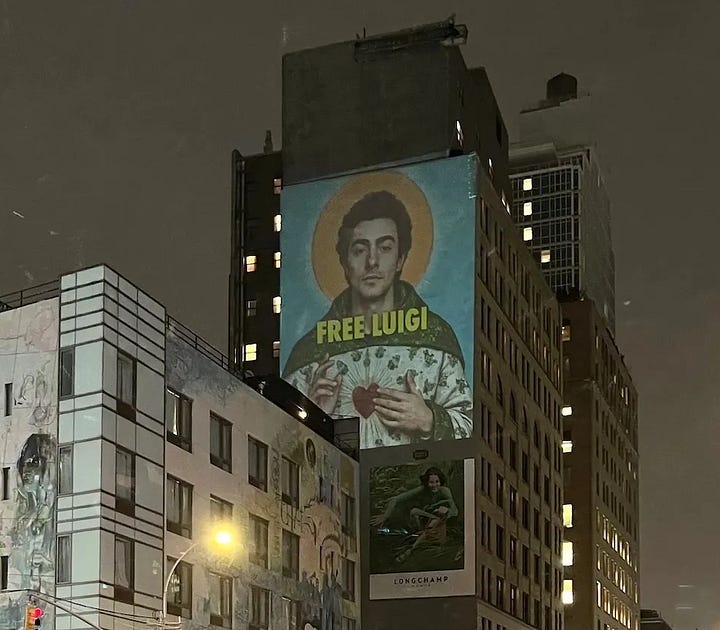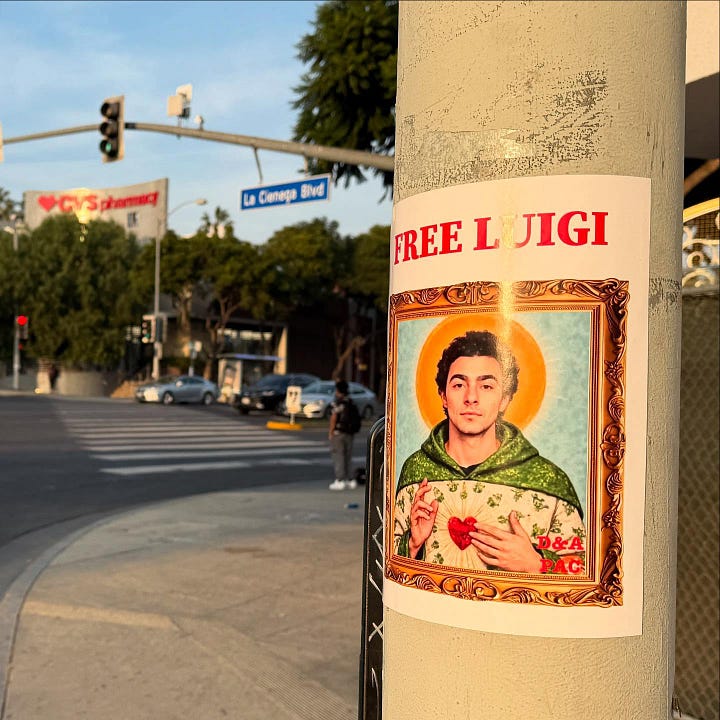Luigi Mangione and Christian Imagery
How the imagery surrounding Mangione’s arrest might signal a return of the Social Gospel
There’s something peculiar you might’ve noticed if you were watching the public’s reaction to the arrest of Luigi Mangione. Amidst the outpouring of support for Mangione, memes began popping up depicting the handsome Ivy League graduate as a saint, and comparing photos of his perp walk to the arrest of Christ. Posters and prayer candles appeared, each with Mangione’s right hand raised in blessing, the sacred heart of Jesus blazing on his chest, and his head ringed by a halo.


I am not interested in discussing whether Luigi Mangione is guilty or innocent, or what sort of sentence the killer of Brian Thompson deserves. Rather, I am interested in what the public’s immediate and almost instinctive association of Mangione with Christian virtue signals about the place of Christianity in contemporary social movements in America.
In the past few decades, the relationship between the American left and Christianity has been strained. This is not because America’s working poor have become less religious; instead, the left wing lost traction among the working poor. The social movements championed by the left which dominated public dialogue in the past few decades have been focused on marriage equality, transgender rights, and abortion access. Many interpretations of the Christian faith have acted as barriers to progress in these areas, making for a frosty relationship between Christianity and the left.
However, this has not always been so. In the late 1800s and early 1900s, the Social Gospel movement swept across America. American Protestants of the late 1800s were disturbed by poor working conditions, gaping income inequality, and the ruthless exploitation of the working poor by robber barons who accumulated stunning wealth and influence. As the movement spread, Americans managed to implement major social reforms—child labour was abolished, the right to unionize was won, and the gap between rich and poor slowly shrunk.
The Social Gospel movement was fuelled by an interpretation of Christianity which placed a strong emphasis on the verse from the Lord’s Prayer “Thy will be done on earth as it is in heaven” (Matthew 6:10).
In heaven, it's quite unlikely that children lose their fingers to spinning machines while their bosses enjoy New York’s gilded age from the comfort of a mansion in the Hamptons. If we can all agree on this simple thought, and we pray ‘thy will be done on earth as it is in heaven,’ then it is our religious obligation to push for social reforms that make the world around us look more like the world we imagine in heaven.
This potent idea spread north of the border too. Tommy Douglas was a baptist preacher, who spread the Social Gospel across the prairie provinces. As a boy, he had a serious bone infection in his leg, which would have killed him, had a top doctor not agreed to perform a series of difficult surgeries on him free of charge.
Today, Douglas is known as ‘the Greatest Canadian’, and the father of universal healthcare. Moving from the pulpit to politics, Douglas was elected premier of Saskatchewan, where he implemented the first universal healthcare program in North America. How did Douglas manage to convince the rough Canadian prairie folk to adopt such a radical policy? It’s simple. He asked them: “How can you be expected to love Jesus if you’ve got a toothache?”
Any effective social movement needs a broad base of support to build on. To form such a base, social projects need to be communicated in a language people are receptive to. For a host of reasons, the American working poor will never be receptive to the Marxist language of the European proletariat. However, Americans have proven to be receptive to the language of the Social Gospel in the past.
After decades of frosty relations between the church and the American left, the public’s immediate use of Christian imagery to represent Luigi Mangione might be signalling a thaw. Sympathy for Mangione cut across traditional party lines—the rural poor are just as cheated by health insurance companies as struggling baristas, and simple Christian imagery provides them with a symbolic language they can both understand.
America’s churches, unions, and left-wing college book clubs ought to take note of the public’s veneration of ‘Saint Luigi’. If they play their hands carefully, the message of the Social Gospel could be revived, coordinating a social movement that’s as American as apple pie.
Of course, Jesus never shot a father of two teenagers three times in the back. Jesus went to the temple, and cleared out the money changers, flipping their tables, and rebuking them for turning God’s home into a playground for money-making. In Jesus’ day, worshippers were expected to purchase sacrifices to present in the temple, and were often swindled out of a good portion of their money along the way. Jesus drove out the people who set up shop in the temple to make a quick buck off of those who had come to worship.
When Jesus cleansed the temple, he wanted to remove barriers between people, and the worship of the Lord. Today, we don’t present animal sacrifices in our churches—Romans 12:1 tells us we ought to make ourselves into living sacrifices, honouring God through our words and deeds. But how can you be expected to love Jesus if you have a toothache?



